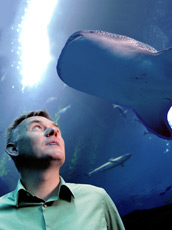The whale shark is brought to you by the letters A, C, T, and G
 |
At the Georgia Aquarium, the whale shark is king of the sea.
Scientists there know that whale sharks can grow up to 40 feet long—they are the world’s largest fish—but they don’t know why they grow so big. Nor do they know how are they related to other fish, or if they are members of one family or of dozens of smaller ones. The person who may be able to fish out those answers is Tim Read.
Read, head of Emory’s GRA Genomics Center, is working with Georgia Aquarium scientists to produce the world’s first genome of the whale shark. In cataloging the fish’s DNA, they hope to unlock the mysteries of the whale shark.
“Mapping the genome is like an encyclopedia of life—it gives scientists the ability to ask questions,” Read says. “In the architecture of the genome, it’s a bit like archeology. We can see the history of the whale shark in its tissue.”
How did Read find himself in this role. He was looking for a large complex project to test a lab machine and contacted the aquarium. The machine, which reads genetic sequences, or letters, is the size of a small copier and is relatively new in the field of genetics. Just 10 years ago, an entire lab would be needed to map a genome. One run of the machine can produce 100 billion letters. The human body, for example, has 3 billion. Read estimates that the whale shark may have 6 billion letters. All living organisms have the same four letters, A, C, T, and G (adenine, cytosine, thiamine, and guanine) in different combinations on each DNA molecule.
Sequencing the whale shark will take months, he says. In the meantime, the aquarium’s gift shop is selling aquatic-themed Silly Bandz to support the whale shark DNA project.
The Genome Center has mapped smaller projects, including butterflies, dirt, and Lake Lanier. Read sees great potential for the center in cancer research. “Cancer is primarily a genetic disease,” he says. “If we found specific mutations within certain cancers, we could potentially use genomics to tell us which drugs to use to treat them.”


